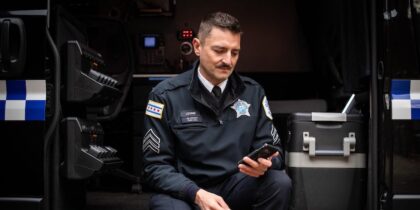It wasn’t that long ago that front-line police officers used only land mobile radios (LMRs) to get real-time information from their dispatchers. Voice-only dispatching had significant limitations, and as technology changed, so did they way officers received real-time information about a call. Shortly after LMRs, came in-vehicle mobile computing with Computer-Aided Dispatch (CAD) software, GPS and automatic vehicle location (AVL) mapping software, and mobile reporting with direct entry records management systems (RMS).
The introduction of this new front-line mobile computing solution drastically changed the way police officers responded to calls and significantly improved police officer safety. Imagine walking into an unknown scenario with nothing more than the address.
Today, officers can get real-time information about premise history, suspect history, suspect mugshots, hazards at the scene, firearms registered to the residence or occupants and other critical pieces of information. While all of this data goes right the laptop in the vehicle what about when the officer leaves the vehicle?
Integrating Technology for Real-Time Information
After stepping out of the vehicle officers are limited to voice only LMR systems and unless they’re writing it all down, it’s easy to miss information, especially while driving to a scene. Closing that information gap when officers leave their vehicle is something many hardware and software vendors are trying to do in a way that enhances police officer safety.
Samsung is focusing resources on addressing these challenges leveraging its industry-leading mobile device portfolio and defense-grade security solutions. Working in combination with several leading CAD software vendors, Samsung is creating smartphone- and smartwatch-based solutions to get critical information to the officer in the field.
Mobilizing Law Enforcement
Plan and implement a mobile initiative at your agency with this practical roadmap. Download Now
Imagine the officer gets out of their vehicle and then gets a suspect description over the LMR, the officer then has to form a mental picture of that suspect and hope it’s close to the real person. The smartwatch alleviates that ambiguity by allowing dispatch to send a color HD mugshot directly to the wrist of the officer. A quick split-second glance at the mugshot removes ambiguity and better equips the officer with the information they need to locate or identify the suspect.
In addition to relevant information, navigation is also very important. According to a recent GfK survey, about 80 percent of the public safety workforce need to navigate to a scene as a part of their role. GPS tracking of most officers stops when they leave the vehicle unless their LMR has GPS. Now, if an officer needs to call for help but is unable to communicate, the mobile device pinpoints the officer’s location to help backup officers arrive without delay.
Outside the vehicle, officers with these new smart devices will have the ability to use their CAD system mapping software to pinpoint the location of an E911 caller. This can help officers quickly respond to incidents, and remove the guesswork of location, reducing risk of further outside dangers. In rural areas, at night, with limited ambient light, this is a significant police officer safety improvement over just a laptop in the vehicle.
Setting a New Precedent for Public Safety
In the high-risk public safety sector, officials are constantly trying to find new ways to increase safety for police officers. Now with these new integrated mobile solutions, the delivery of real-time information and the ability to respond to a changing environment will never be the same. With the introduction of mobile technology, departments can introduce new capabilities to their officers in the field.
This means that decision-makers should not only investigate the changing trends in public safety technology and even consumer-based mobile devices, but also evaluate which types of mobile devices would best suit their own officers. In doing so, departments can increase adoption, create a more intuitive user experience for officers and gain access to incredibly insightful real-time incident information.
See how adding mobile technology to law enforcement can help increase police officer safety.









